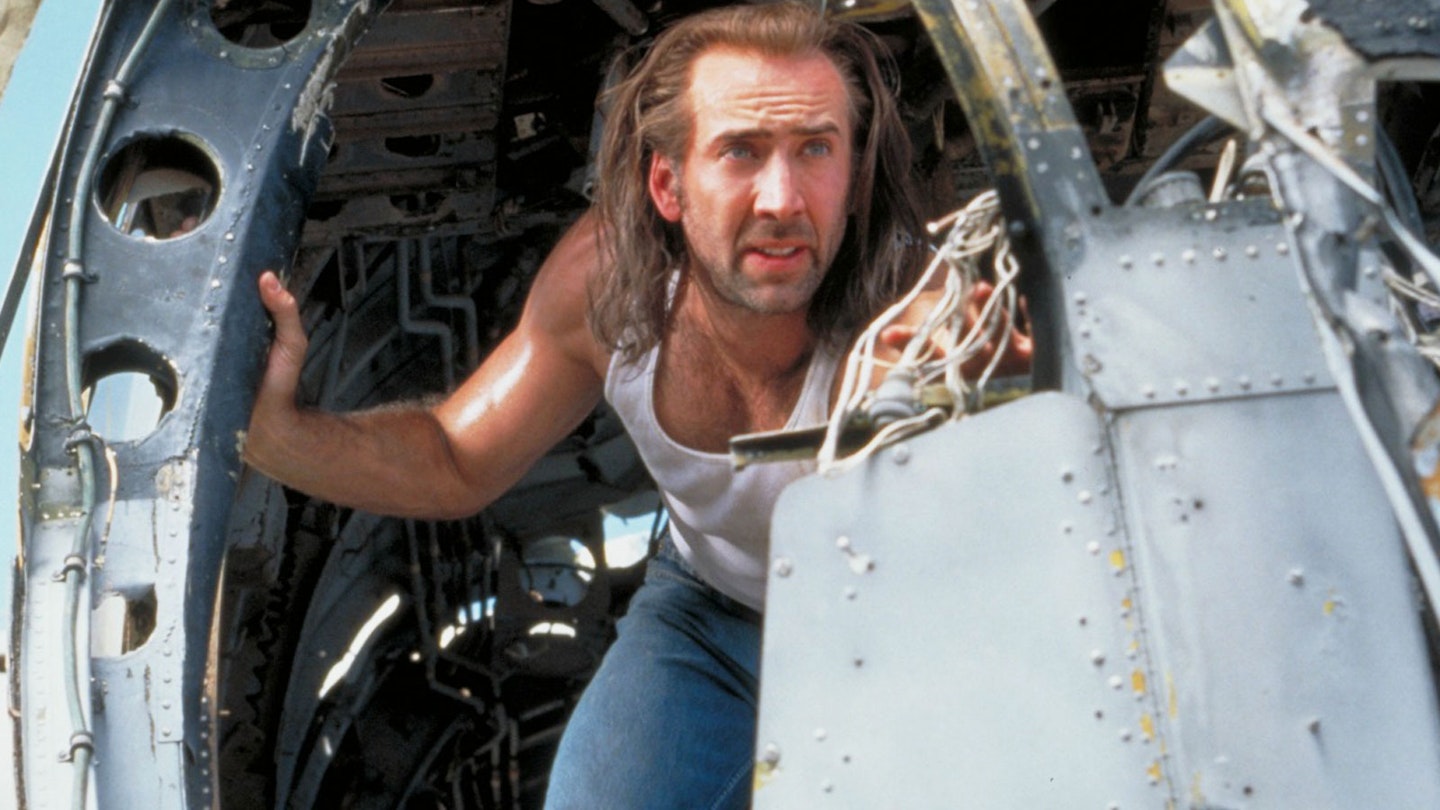The story of a man just trying to get home. The role that turned Nic Cage into an inimitable on-screen hero. An exercise in excess, explosions and extremely silly hair. Yes, we're talking about Con Air, Simon West's gloriously chaotic, impeccably cast, testosterone-fuelled 1997 action classic, which turns 25 today. To celebrate, revisit Empire's feature charting the making of the movie, first published to mark the film's 20th anniversary in Issue #339.
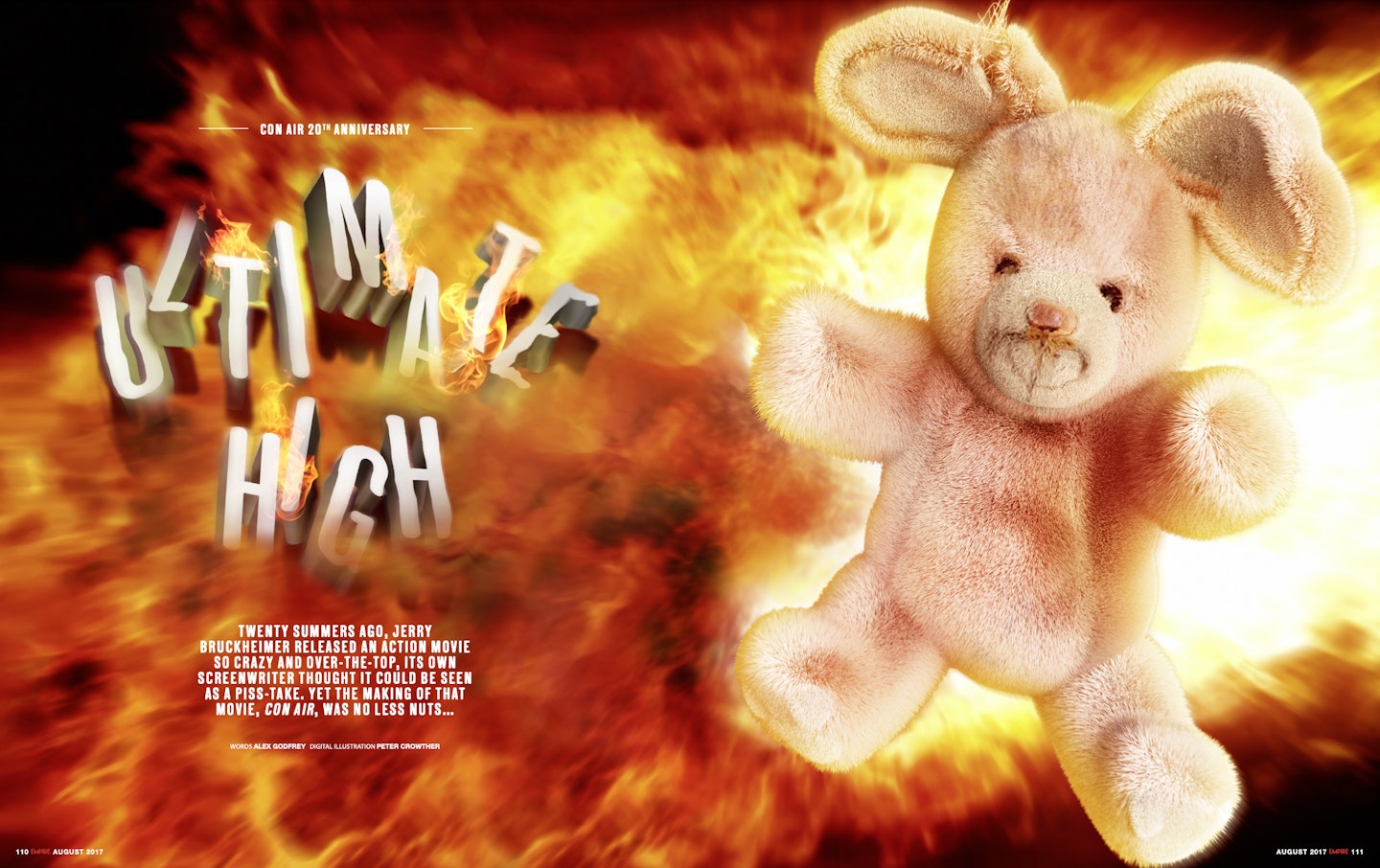
Just a few days after winning a Best Actor Oscar for playing a suicidal alcoholic in Mike Figgis’ $3.5 million-budgeted drama Leaving Las Vegas, Nicolas Cage was in prison.
He, producer Jerry Bruckheimer, director Simon West and writer Scott Rosenberg were visiting Folsom, a maximum-security facility in Sacramento, California — all part of their research for a $70 million action blockbuster they were making. After signing a no-hostage waiver (to ensure that, should a prisoner injure or kill them, their families wouldn’t sue), they walked into the yard. It was busy: 2,000 prisoners talking and exercising. “Gradually they started to recognise Nic,” says Rosenberg. “And bigger and bigger groups started to gather around asking questions.” One wanted to make a film with him. “And one guy came up to Nic and said, ‘Holy cow, it’s really you!’ Nic said, ‘Yeah, it’s me.’ And the guy said, ‘Yeah! It’s you! Jerry Seinfeld!’”
Cage was not impressed. But as more and more cons approached him, the Hollywood crew got anxious. “You could feel it getting slightly out of control,” says Rosenberg. And then, across the yard, a stabbing. Guards grabbed the filmmakers and hustled them out of the yard. Fast. “I say this now,” says Bruckheimer, “I felt okay — but that’s ’cause I’m out of there. I was nervous.” To borrow a line from the film itself: welcome to Con Air.
The ultimate high-concept napkin pitch (“Prisoners on a plane!”), it was the pinnacle of late-’90s action-movie excess, an outrageous film that cared little for logic, amplifying everything until the amplifier broke. A Bruckheimer blockbuster directed by an Englishman who’d never made a film and starring indie actors who had no business being in such a production, it revelled in its own ridiculousness. But as the Folsom excursion suggests, the craziest parts of all happened off-camera.
Ironically for a movie so removed from reality, Con Air is rooted in fact. In August 1993, Los Angeles Times staff writer Eric Malnic heard about the Air Operations Division of the US Marshals Service, which flies prisoners around the country for transfers, medical examinations and court appearances on Boeing 727s. Malnic wrote about it in an article entitled ‘When Jailbirds Fly, They Always Use ‘Con Air’’. Of course, a guard told him, convicts dreamt of using the service to escape, adding that a successful attempt had never occurred: “If they bite or spit, we put pantyhose over their heads.”
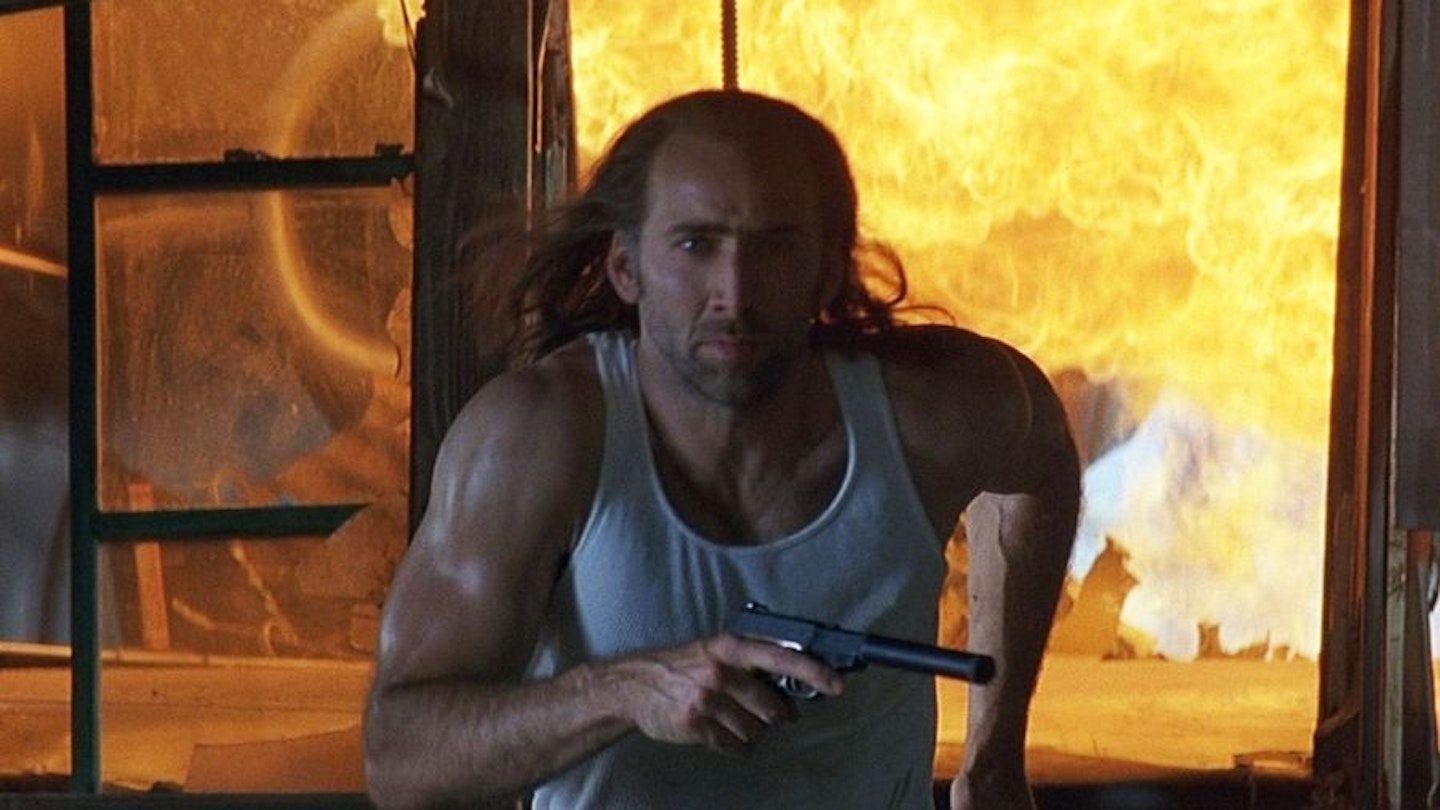
Donald De Line, then president of Disney’s adult offshoot Touchstone Pictures, thought it would make a good movie, and Todd Garner, then vice president of production, began looking for a screenwriter. Rosenberg’s screenplay for Things To Do In Denver When You’re Dead, a twisted character-driven drama inspired by his father’s death, was getting a lot of buzz, so in 1994 Garner hired him for Con Air. The writer spent a jovial three days flying with some cons, then wrote a draft.
The story’s driving force was Cameron Poe, a former street hood on the verge of freedom who just wanted to get home to his daughter but found himself, says Rosenberg, “on the wrong plane with the worst possible people you could be on with”. Characters were musically inspired. Rosenberg listened to Lynyrd Skynyrd and The Allman Brothers Band while writing, and Poe was a take on the respective southern rock frontmen, long-haired beardies Ronnie Van Zant and Gregg Allman. Black Guerillas general Diamond Dog got his name from David Bowie’s hit, rapist Johnny 23 was a take on Bruce Springsteen’s 'Johnny 99', and cross-dressing Sally Can’t Dance was a Lou Reed song.
Touchstone gave it to Bruckheimer to produce. “I thought it was a terrific idea,” says Bruckheimer now. “It just needed to be more realised on the page. So we went to work on it.” On the set of Michael Bay’s The Rock, Bruckheimer passed the script to Cage, who loved it. Together the pair started making Poe more sympathetic, changing him from a random thug to a virtuous Army Ranger, while it was Cage himself who decided that Poe would have a plush toy bunny to gift his daughter, to be protected at all costs.
“Scott called me ‘the enlarger'. He would write a line and I would turn it into a five-page cacophony of mayhem. It went from this small, character-driven thing to this giant overblown spectacle.” – Simon West
Bruckheimer liked to recruit directors who’d worked in commercials, for their big ideas and visual chops, such as Top Gun’s Tony Scott and Flashdance’s Adrian Lyne — Bruckheimer himself had begun his career producing ads. There was a meeting with Britain’s Tony Kaye, who would go on to make American History X, but, at the time, was still to make a feature. By his own admission in a 2012 interview, he was idiotic. “We should go to prisons and get real convicts to make the movie. It’s the only way,” he told Bruckheimer executives. “What about actors?” they asked. “No, that’s stupid,” he said. He didn’t get the job.
Meanwhile, Simon West landed on Bruckheimer’s radar. Another Brit, West was directing music videos — including Rick Astley’s 'Never Gonna Give You Up' — and commercials, because he wanted to make films and had seen others graduate the same way. It worked. Impressed with his output, Bruckheimer called West in for a meeting and gave him Con Air; West loved it. He took the job and then, at Bruckheimer’s request, immediately set about working with Rosenberg on making it more bananas. The plane shrunk — instead of the Boeing the real Con Air used, West wanted a small jet that looked like an old prison bus — but the action got bigger.
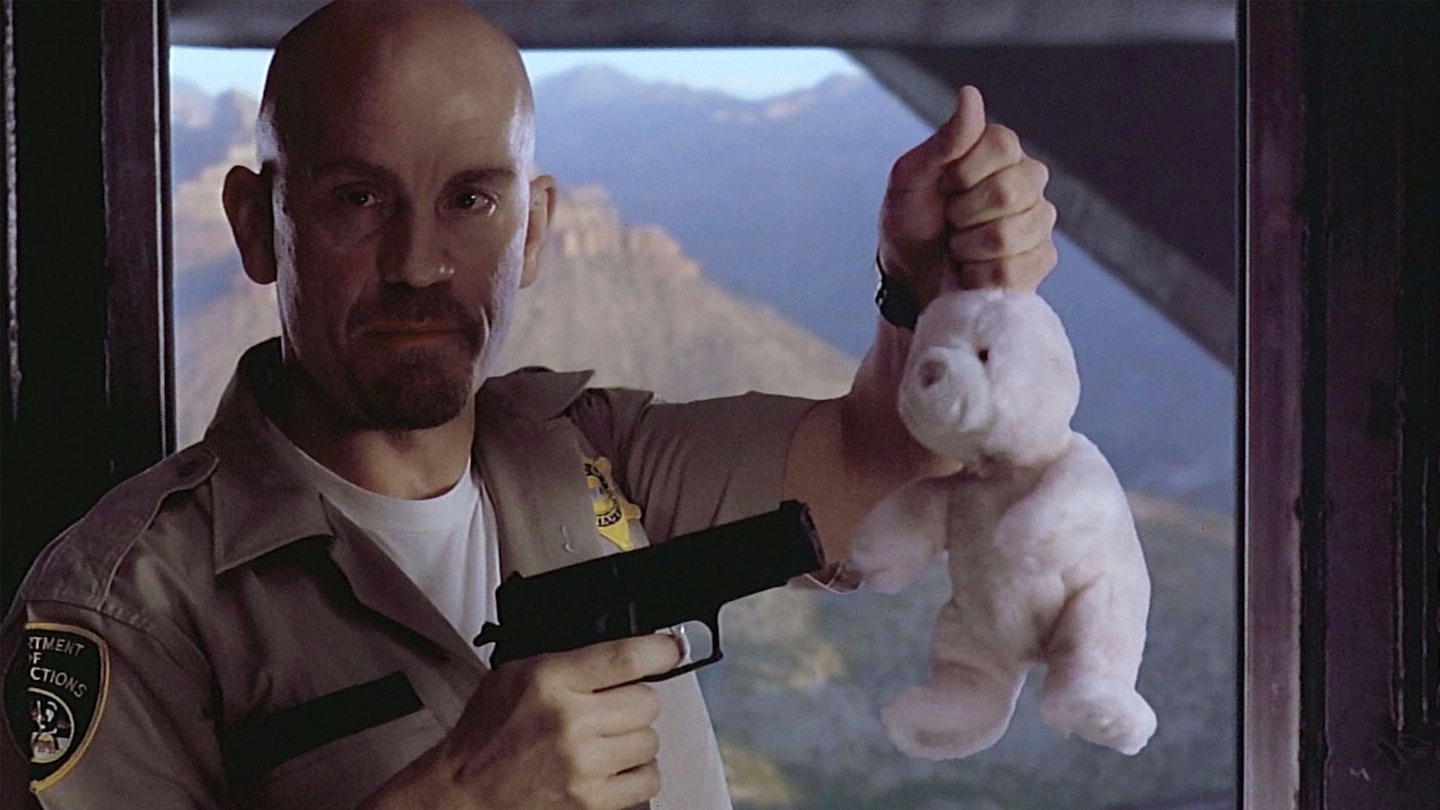
“Scott called me ‘the enlarger’,” says West. “He would write a line and I would turn it into a five-page cacophony of mayhem. It went from this small, character-driven thing to this giant overblown spectacle.”
Rosenberg admits that, at its core, Con Air is “a pretty ridiculous movie. We weren’t really quite sure if we were making a Jerry Bruckheimer movie or taking the piss out of a Jerry Bruckheimer movie. We weren’t sure what Jerry thought.”
But Bruckheimer knew he wanted it funny. He was the one who kept pushing the absurdity, and at one point hired J.J. Abrams, then known as a comedic screenwriter for films such as Gone Fishin’, to contribute jokes. Abrams was also writing on Armageddon; “He was our go-to guy,” says Bruckheimer. Abrams gave them a few lines for Con Air, including Poe deadpanning as the DEA Duncan Malloy’s Corvette, tied to the back of the plane, trails behind in the sky, “On any other day, that might seem strange.” And on the production itself, things only got stranger.
Casting Con Air was nuts. Rosenberg was friends with Steve Buscemi and wrote mass-murderer Garland Greene for him. Even so, the script got around and Rosenberg received a package in the mail. “I opened it and it was a baby doll’s arm covered in blood,” he recalls. “And there was a note with it saying, ‘I am Garland Greene.’ It was from Denis Leary. He really, really wanted that part.” Rosenberg wouldn’t waver.
“Nic loved that long hair so much. The scene near the beginning when he comes off the prison bus and hits the wind and it’s like a Fabergé commercial? That was Nic’s moment for his hair to shine, literally.” – Todd Garner
For US Marshal Vince Larkin, they wanted John Cusack, who didn’t care for the script, but figured that starring in a blockbuster would give him increased industry leverage. It also paid substantially. Cusack had one demand. To bring something of himself to Larkin, says Rosenberg, he insisted on wearing idiosyncratic footwear. “He was like, ‘I wanna create the very first action hero who wears Birkenstocks. Charlton Heston wore sandals and he kicked ass. I wanna do the same.’ Thus, Larkin wears sandals.”
Last to be cast was the film’s chief evildoer, big-brained Cyrus The Virus. Bruckheimer approached Bruce Willis, but he turned it down. John Malkovich was an early idea, but Bruckheimer asked West to audition a host of big names. Tom Sizemore read for it, as did Willem Dafoe, who gave a very sinister audition. And then came someone who was too close to the bone.
“Mickey Rourke was a particularly harrowing audition,” shudders West. “He was doing a confrontational scene and there was this young assistant casting director reading the Poe part opposite him. Mickey Rourke was eyeball to eyeball, nose to nose with him, and then pulls out this 10” Bowie knife from behind him, which was totally real and incredibly sharp. And he held it under this poor guy’s chin. And me and the casting directors froze — do we intervene, do we wrestle him to the ground? Is this great acting, or has he lost the plot and is going to kill us all? I’m ashamed to say we did not intervene. We let him finish the scene. So it was a pretty powerful audition, that one.” Even now he sounds relieved.
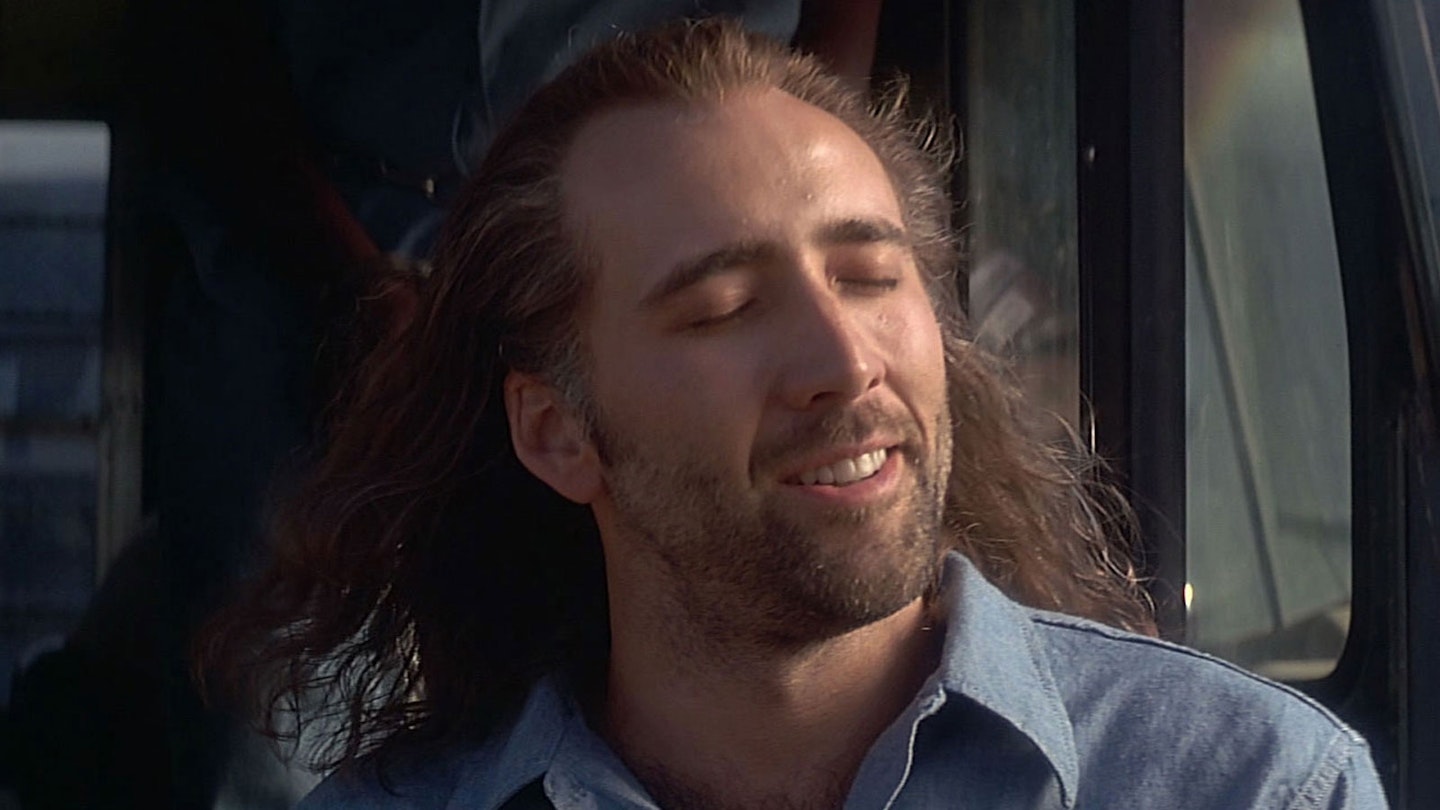
Finally, Bruckheimer asked West to choose. West said he still wanted Malkovich, and they cast him without an audition. “So Malkovich flew in from France two days before the shoot,” says West, “and we squeezed him into his orange jumpsuit.”
Cage arrived, ready to go, with — inspired by Rosenberg’s talk of Poe being cut from the same cloth as Ronnie Van Zant and Gregg Allman — a full, thick beard. “We can’t have him look like that,” said Bruckheimer. “Jerry’s thinking was, ‘You don’t pay a guy $20 million and then cover up his face,’” says Rosenberg, who loved the beard, but because Bruckheimer saw it as his fault, was instructed to tell Cage to shave. Rosenberg skulked off to Cage’s trailer. A crestfallen Cage acquiesced, and as his make-up lady shaved him, his face dropped. “I’ve lost Cameron Poe,” he said. “I could see him leave the character,” says Rosenberg. “For him, the beard was part of it. He looked momentarily lost. But he got Poe back.” As a compromise, Cage kept a five o’clock shadow, and insisted on having his long hair flow; Bruckheimer had wanted it in a pony-tail. “Nic loved that long hair so much,” says Garner. “So, the scene near the beginning when he comes off the prison bus and hits the wind and it’s like a Fabergé commercial? That was Nic’s moment for his hair to shine, literally.”
Filming began on 1 July ’96, with Salt Lake City International Airport doubling for Con Air’s base. Cage was fully invested, totally prepared and rarely went beyond three takes. Malkovich, on the other hand, “appeared not to have read the script,” West says, and just asked the director each time what he wanted him to do before coming up with hilarious, expletive-strewn improvisations. Cusack, while great, didn’t hide his disdain for the film. For Rosenberg, it was disheartening. “It was kind of a bummer. He thought he was selling out.”
Then came madness. For eight weeks, for the shooting of the siege in Lerner Airfield, they all lived and worked in Wendover, a 1.6 mile-long strip of nothingness on the Nevada/Utah border, chosen by West because he thought it looked like the moon. The 400-strong cast and crew there counted just two women. Some supporting actors playing minor roles had done time, as had a few of the crew. And it was hot: temperatures hit 120 degrees.
"Everybody was stripped to the waist all the time because it was so hot. There was competition over who could do the most pull-ups and push-ups.” – Simon West
“You can imagine, it got pretty macho out there in the desert,” says West. “Everyone went a little crazy. They built a dojo so at lunch they could all fight and wrestle each other, and it did become a bit like a prison. Everybody was stripped to the waist all the time because it was so hot, everyone was showing off their muscles. There was competition over who could do the most pull-ups and push-ups.” In a podcast interview last year, Ty Granderson Jones, who played the convict Blade, said there were often fights brewing, and he punched a few guys who wanted to cause trouble with him. Danny Trejo, who played Johnny 23 and spent years in the penitentiary system himself, has said it was the biggest test of testosterone he’d ever seen.
Cage, Trejo claimed, was the baddest baddass of them all, while West describes him as “ripped” and says, “He could beat everybody, hands down. He did 70 one-arm push-ups, or something ridiculous,” though he mostly kept to himself. “Nic was in the craziest shape of his life,” Rosenberg tells us: sober, eating macrobiotic food, working out constantly in his mobile gym, behaving “like a monk”. The other big leads also kept away from the off-screen debauchery, of which there was much. “In Wendover there was one Pizza Hut, one Blockbuster video and one little casino,” says West. “And a strip club. Which was called The American Bush. I would be shooting all day and was exhausted at night, going back to my hotel room and preparing for the next day, but 400 guys would descend en masse on this little town and basically take it over.”

Chaos continued when the production moved to Las Vegas to film the climax. “It was crazy,” says Rosenberg. “These guys were cooped up in that little town, then all of a sudden they’re unleashed in Vegas. It was like the Vikings attacking, looting and sacking.” Oftentimes, when people were needed on set, they were nowhere to be found. “I’d be shooting and I’d say, ‘Where’s so and so?’” says West. “And someone would say they were in a casino. We’d have to send people out to track them down.”
West’s original idea for the climax was to have the plane crash into The Mirage casino’s fake volcano, which would then erupt on cue, the plane sinking into the lake, leading to an underwater fight between Poe and Cyrus. But that went kaput when Mirage owner Steve Wynn read the script. Wynn wanted to move The Mirage away from Vegas’ Sin City reputation and attract families, and didn’t want the association with an R-rated film. So West was without his location.
“More and more crazy shit just kept happening. That was the directive. It really was a big, absurd enterprise." – Scott Rosenberg
But the director had recently read in the Los Angeles Times that the Sands casino was closing down, scheduled to be demolished. He asked them to delay the demolition until they got there, and they agreed. Although the first part of the crash, the plane causing carnage as it descended, was done with miniatures, the rest was real: they smashed all hell out of the place. And then, after filming a post-climax climax with motorbikes and a fire engine, they were done.
The first test screening took place in Arizona. “It was going along fine,” remembers Todd Garner, “until the scene with Garland Greene and the little girl” — Rosenberg’s homage to Frankenstein. The original cut of that sequence, in which Garland meets the child in a trailer park, was considerably longer, the tension “excruciating” says West. “About a minute-and-a-half into the scene,” continues Garner, “a woman stood up and turned to us and said, ‘Why are you guys doing this to us?’ And walked out. [Former Disney CEO] Michael Eisner turned to me and [former Disney chairman] Joe Roth and said, ‘We’re gonna cut that down, right?’ And we said, ‘Oh yeah, definitely.’” It was just too intense. “Yeah, the bosses were not happy,” laughs Rosenberg. “It was supposed to be a big popcorn movie. It wasn’t supposed to be a Cronenberg film.”
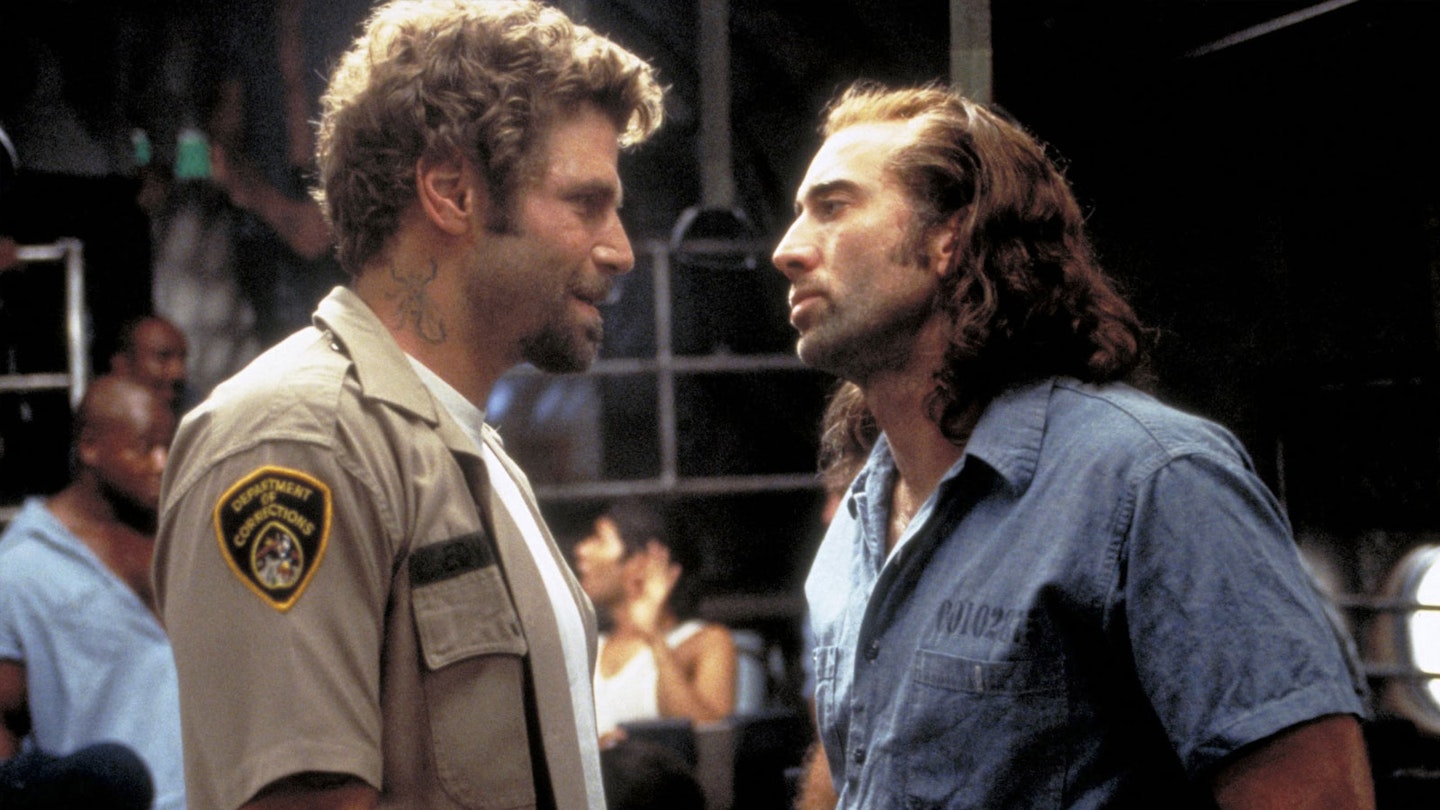
Con Air premiered, appropriately, at Las Vegas’ Hard Rock Hotel & Casino, which the plane crashes through during its final descent. Guests were flown in from LA on a 737 and, arriving on the Tarmac in Vegas, were shouted at by ‘prison guards’, who shoved them all onto fake prison buses with batons, convoys driving them down the strip. At the Hard Rock, a replica of Con Air’s plane had been supposedly crashed into a pop-up cinema. Guests were led through the plane into a tunnel which housed prison cells, behind which ‘prisoners’ shouted at them and gave them popcorn. Just before showtime, guards shoved a prisoner onto the stage, dressed in an orange jumpsuit and wearing a spit guard. The prison officers pulled off his spit guard, revealing Bruckheimer, who duly introduced the film.
Eric Malnic, writer of the article that started it all off, was there. “To say that Touchstone’s version of Con Air differed somewhat from mine — and from the reality of the federal prisoner transportation system — would be an understatement,’” he wrote in the Los Angeles Times. Bruckheimer, promoting the film on the Charlie Rose show, said, “We just added some drama and stretched reality a little bit.” Just a bit.
Con Air grossed $224 million worldwide. Reviews were mixed, but most recognised the sheer fun of the thing; Empire gave it four stars, calling it “an adrenaline blast of the highest order… magnifying every excess to previously untapped levels”. While 1996’s The Rock introduced Cage as an action star, Con Air made a fully fledged, outsized hero of him, and he made John Woo’s Face/Off immediately after.
Rosenberg has a memory of West eating lunch on set, being given spaghetti sauce and saying, “More. More. More.” That, says Rosenberg, sums up the film. “More and more crazy shit just kept happening. That was the directive. It really was a big, absurd enterprise. But the fun and the ebullience and the feeling that none of us will ever get to make a film in this way again — I think you feel [that] on the screen.”
To Bruckheimer, it’s just “a fun romp”. Nonetheless, he says he’s very heartened every time he reads about how much affection people have for it. Rosenberg, meanwhile, is happy with haters, too. In a 2012 interview, Sideways and Election director Alexander Payne was asked if films ever make him upset, and he immediately cited Con Air, calling it “completely amoral”. Rosenberg laughs heartily. “I would take that as truly the height of praise,” he claims. “Nothing makes me happier than him saying it was amoral. Yeah, we got one through! We got an amoral film through the net.” A gleeful, alpha, bratty statement. Just like Con Air itself.
